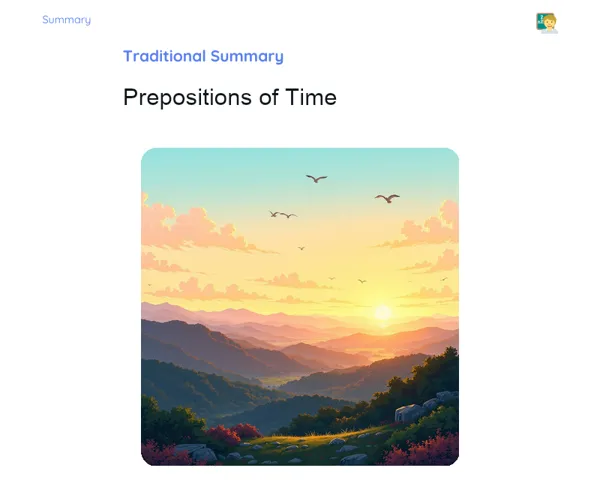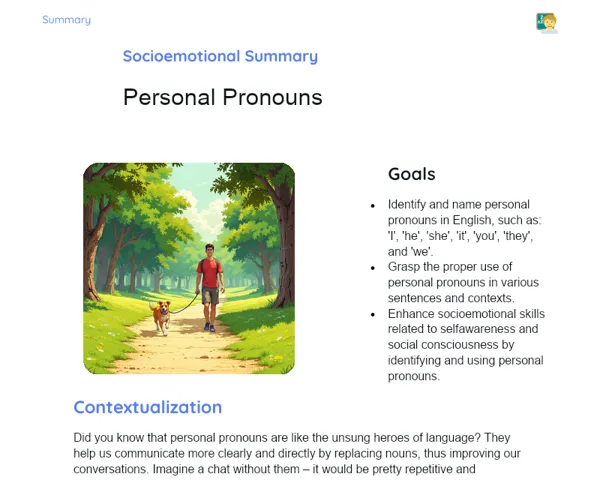Summary Tradisional | Verbs: Passive Voice
Contextualization
The passive voice is a common grammatical structure in English, particularly in formal, scientific, and journalistic settings. Unlike the active voice, where the subject executes the verb's action, in the passive voice, the subject experiences the action. For instance, in 'The cat chased the mouse' (active voice), 'the cat' is the one doing the chasing. In 'The mouse was chased by the cat' (passive voice), 'the mouse' is the one being chased. This construction is especially useful for highlighting the outcome or object of the action, rather than who carried it out.
Grasping the passive voice is crucial for reading and creating texts in English, as it's frequently found in news articles, academic papers, and technical manuals. An example might be a newspaper report stating, 'A new vaccine was developed', which stresses the vaccine's significance without centering on the scientists involved. This approach allows for clearer and more objective communication, particularly when the doer of the action is less important than the action itself or its outcome.
To Remember!
Definition of Active and Passive Voice
Active and passive voice refer to how the relationship between the subject and the action of the verb is expressed in a sentence. In the active voice, the subject carries out the action. For example, with 'The cat chased the mouse', 'the cat' (the subject) is the one performing the action of chasing. This structure is direct and straightforward in everyday conversations.
Conversely, in the passive voice, the subject of the sentence receives the action of the verb. For example, 'The mouse was chased by the cat' indicates that 'the mouse' (the subject) is on the receiving end of the chasing. The passive voice often emphasizes the result of the action or the object receiving it rather than the doer of the action.
Understanding these forms is important as it allows for variation in sentence structure based on context and emphasis. In formal, scientific, or journalistic writings, the passive voice can be a valuable tool for focusing on the action or the object instead of the agent who executed it.
-
The active voice centers on the subject that performs the verb's action.
-
The passive voice prioritizes the subject that receives the verb's action.
-
Choosing between active and passive voice depends on the context and focus needed.
Structure of the Passive Voice
The structure of the passive voice involves the verb 'to be' used in the correct tense, followed by the past participle of the main verb. For instance, in 'The meal was cooked by the chef', 'was cooked' represents the passive form, where 'was' is the past tense of 'to be' and 'cooked' is the past participle of 'to cook'.
A key aspect of crafting the passive voice is ensuring that the verb 'to be' aligns with the tense of the original active voice. For example, if we have 'The chef cooks the meal' in the present tense, the passive version becomes 'The meal is cooked by the chef'. When the active sentence is in the past, the passive voice would be 'The meal was cooked by the chef'.
It's essential to select the proper tense of 'to be' and accurately apply the past participle for grammatically correct passive voice construction. Moreover, the passive voice can appear in various tenses such as present continuous ('The meal is being cooked'), past perfect ('The meal had been cooked'), and simple future ('The meal will be cooked').
-
Passive voice structure: verb 'to be' + past participle.
-
The verb 'to be' must correspond with the active sentence's verb tense.
-
You can use passive voice in multiple verb tenses.
Transformation of Sentences
To change sentences from active to passive voice, follow a clear process. First, identify the subject, verb, and object of the active sentence. For example, in 'The chef cooked the meal', 'The chef' is the subject, 'cooked' is the verb, and 'the meal' is the object.
Next, turn the object of the active sentence into the subject of the passive one. The passive sentence would start with 'The meal'. Then, pick the right form of 'to be' that matches the active sentence's verb tense. Since 'cooked' is in the past, the correct form of 'to be' is 'was'. Finally, include the past participle of the main verb ('cooked'), followed by the agent of the action using 'by' ('by the chef'). Thus, the fully transformed passive sentence reads, 'The meal was cooked by the chef'.
Practicing sentence transformations is vital to become accustomed to the adjustments in grammatical structure. These exercises help to internalize the logic behind the passive voice and apply the rules accurately.
-
Identify the subject, verb, and object in the active sentence.
-
Change the object from the active voice to the subject of the passive voice.
-
Select the proper form of 'to be' and the past participle of the main verb.
Use of the Agent in the Passive Voice
In the passive voice, the agent—the person performing the action—is typically introduced by the preposition 'by'. For example, in 'The meal was cooked by the chef', 'the chef' is the agent. However, we can omit the agent if it's not essential or if it's evident from the context.
It's quite common to see passive sentences without the agent, particularly when the focus is on the action or the object of the action, rather than the doer. For instance, with 'The homework was completed', the agent (the person who completed it) isn't specified, as the emphasis lies on the fact that the task was finished.
Deciding whether to include or leave out the agent hinges on the context and what information one wishes to highlight. In scientific and journalistic writing, excluding the agent boosts objectivity and directs attention to the action's result.
-
The agent in passive voice is introduced by 'by'.
-
The agent can be left out when it's not crucial.
-
Whether to include or omit the agent depends on the emphasis intended.
Key Terms
-
Active Voice: Structure where the subject performs the action of the verb.
-
Passive Voice: Structure where the subject receives the action of the verb.
-
Verb 'to be': Auxiliary verb used to form the passive voice.
-
Past Participle: The form of the verb used in the passive voice.
-
Agent: The one performing the action in the passive sentence, introduced by 'by'.
Important Conclusions
Throughout the lesson, we highlighted the key difference between active and passive voice, noting how the grammatical structure shifts attention from the subject who executes the action to the object that receives it. We established that the passive voice is constructed using the verb 'to be', conjugated to match the appropriate tense, followed by the past participle of the main verb. This structure is particularly prevalent in formal and scientific writing.
We also delved into the methods for changing sentences from active to passive voice, stressing the importance of accurately recognizing the subject, verb, and object in the active sentence. Furthermore, we discussed when it's appropriate to either include or exclude the agent of the action, based on the context and what you want to emphasize in the sentence.
Mastering the passive voice is vital for crafting clear and objective English texts. This skill not only enhances communication accuracy but also bolsters our ability to interpret intricate texts across various domains, including journalism, science, and literature.
Study Tips
-
Review the examples of passive voice sentences discussed in class and practice transforming new sentences from active to passive.
-
Read scientific articles, news reports, and other formal texts in English to spot the use of passive voice and deepen your understanding of its context and application.
-
Complete grammar exercises focused on passive voice to cement your knowledge and familiarize yourself with different tenses and structures.



